
Month: November 2016
Trondheim Soloists: Vaughan Williams, Fantasia on a Theme of Thomas Tallis, etc.
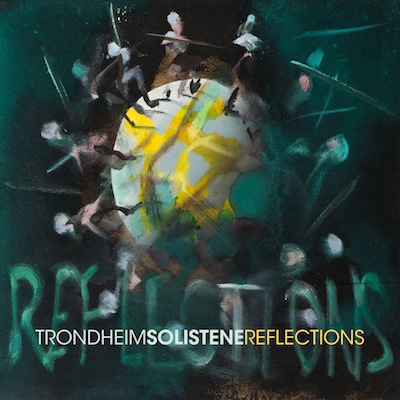
Trondheim Solistene: Reflections
(Music of Britten, Vaughan Williams, and Stravinsky)
SACD/CD +Blu-ray 2-disc set, 2L 125
CDQ; high-resolution stereo including MQA and DSD; and surround-sound downloads available from www.2L.no
Streaming available from various services linked to here.
Recorded June and August 2015, Selbu Church, Norway. Recording producer and balance engineer Morten Lindberg; recording technician Beatrice Johannessen.
Certain pieces of music just catch the ear. Some of those pieces even enter into the collective repository of culture—they become part of the sonic landscape (or the musical memories) of nearly everybody’s life.
A prime candidate for the title of “The Most Well-Known Piece of ‘Classical’ Music That Was Not Composed by Vivaldi, Beethoven, or Gershwin” is Samuel Barber’s Adagio, in its string-orchestra version. Barber’s Adagio for Strings combines striving with yearning (and grief with resignation) in a completely arresting and inescapably memorable way.
Most music lovers don’t realize that the version they know so well is a transcription—that the “Adagio” of movie and pop-culture renown started out life as the slow movement of Barber’s Op. 11 string quartet.
The point of this blog entry then, is to tell as many people as possible that if you love Barber’s Adagio, you will love Ralph Vaughan Williams’ Fantasia on a Theme by Thomas Tallis. The Tallis Fantasia has the same sweeping grandeur and emotional intensity as Barber’s Adagio, but I think it is even more rewarding to engage with over repeated hearings.
More background, a making-of video, and sound bytes, after the jump. Continue Reading →
Rega Research Ltd. Planar 3 Turntable Package
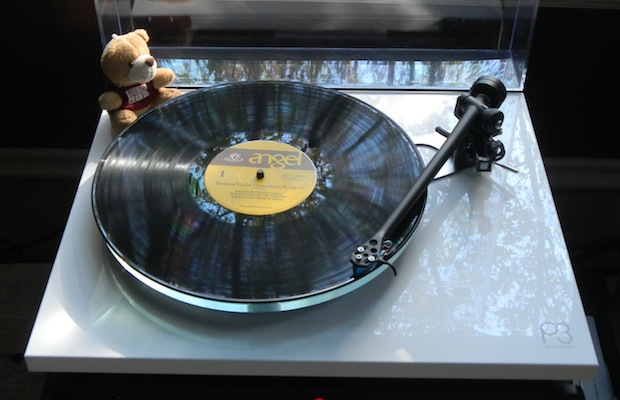 Photo by John Marks; Berlin the Bear not included.
Photo by John Marks; Berlin the Bear not included.
This is the second installment in a series about choosing Pareto-Optimal equipment to make digital archival copies of vinyl LP (long-playing) phonograph records. The first part is here. But even if you are not planning on making digital transfers, you might be interested in my advice on turntables and phono stages.
The turntable system (by which I mean the turntable itself; the tone arm; and the phono cartridge) is both the beginning of the playback process and, by the nature of things, the most critical bottleneck.
After the jump, more on that; and, well-deserved words of praise for Rega’s Planar 3. Continue Reading →
Hélène Grimaud: Busoni, Chaconne for Piano in D minor (after J.S. Bach)
Johann Sebastian Bach wrote a series of six works for solo violin. Three are sonatas. “Sonata” is a technical term that in its largest sense simply means a piece of music meant to be played rather than sung. The other three solo-violin works are partitas, which means that they are made up of parts or movements, usually dance forms.
Bach’s second solo-violin partita’s final movement, a set of variations on a bass line called a Chaconne, is as long as the other four put together. Early on, Bach’s solo-violin Chaconne took on a life of its own, both for being played (at times) without the other four movements, and in various transcriptions and arrangements.
Arrangements or transcriptions exist for orchestra, piano, organ, guitar, cello, and saxophone quartet. Ferruccio Busoni‘s version really amounts to a major re-working of the piece in an overheated fin-de-siècle keyboard-virtuoso aesthetic. The good news is that the architectural structure of the solo-violin piece is substantial enough and resilient enough that the result is musically valid—at least for most of us.
Here’s high-energy Hélène Grimaud in an electrifying live version. To cite just one example, the arpeggio variation that starts at about 6:04 is a marvel of precision and clarity. Arkivmusic.com lists recordings by 36 pianists. So if Ms. Grimaud is a bit too out there for you, there are lots of choices. If I had to choose one and only one, it would be one of Shura Cherkassky’s: either the historical EMI one (circa 1956), or the autumnal Nimbus one (1987).
# # #
Alexander Kerr, Rhode Island Philharmonic, Barber Violin Concerto
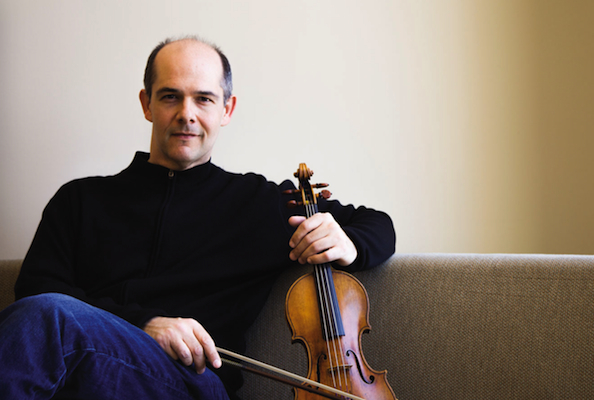
Over the course of time I have owned recordings of Brahms’ violin concerto by at least 14 different violinists. For a few of those violinists, I obtained recordings of more than one performance. And for one performance, David Oistrakh’s 1969 away game with George Szell and the Cleveland Orchestra, I collected multiple formats (LP, CD, and SACD), including at least half a dozen different LP pressings ultimately (and however multifariously) derived from the same original master tape. (OK, call me a bit barmy.)
The violinists whose Brahms concerto performances I purchased and kept (rather than passed along or donated) ranged from Kreisler and Menuhin and Heifetz and Kremer to… Uto Ughi. To say the least, Cavalier Uto’s career in the US has not been, um, huge. From the violinists whose names were not household, my favorite recording was by Hermann Krebbers. Krebbers, who was perhaps as little-known in the US as Ughi, recorded the Brahms concerto with Bernard Haitink and the Royal Concertgebouw Orchestra in 1973.
Please click on the jump link to learn the relevance of all that to Alexander Kerr’s truly wonderful Barber concerto performance with the Rhode Island Philharmonic, as well as an embedded audio-only YouTube of Kerr’s Decca recording of a charming Shostakovich film-score number. Continue Reading →
Emerson Quartet: J.S. Bach, The Art of the Fugue
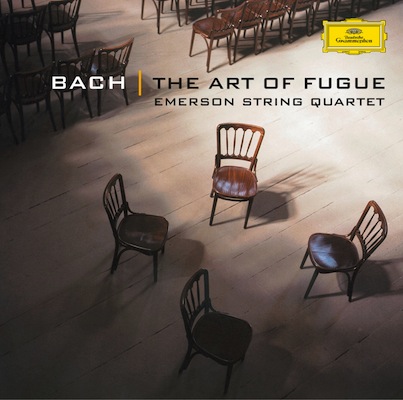 Courtesy of Deutsche Grammophon; cover photo by Marco Borggreve.
Courtesy of Deutsche Grammophon; cover photo by Marco Borggreve.
The Emerson String Quartet: J.S. Bach, The Art of the Fugue, BWV 1080
CD Deutsche Grammophon 474 495-2
(Streaming via Tidal; no hi-res download appears available.)
Recorded January and February 2003 at the American Academy of Arts and Letters, New York City. Da-Hong Seetoo, producer and engineer.
One of the bits of musical non-trivia that I have carted around me for ages is the fact that American composer Roy Harris (whose third symphony is for me the best example of mid-twentieth-century, typically exuberant American musical creativity) also, with collaborator M.D. Herter Norton transcribed for string quartet Bach’s The Art of the Fugue.
M.D. Herter Norton, by the way, was Margaret (also sometimes Mary; and, informally Polly) Dows Herter, who with her husband W.W. Norton founded the publishing firm that bears his name. (W.W. Norton is still a major publisher—if not the major publisher—of music-history texts and anthologies for college use in the English-speaking world.) Margaret Norton was a violinist, an independent scholar of music, and translator from the German of about a dozen volumes of the poetry of Rainer Maria Rilke. She was very important in the early years of the American Musicological Society, as well as co-authoring, editing, or translating articles for the The Musical Quarterly.
After the jump, there is a scan of the cover of that score, from 1936. And generous sound samples. I think most music lovers will find this CD (or the stream from Tidal) extremely rewarding.
A Piece of the First Transatlantic Cable (1858)
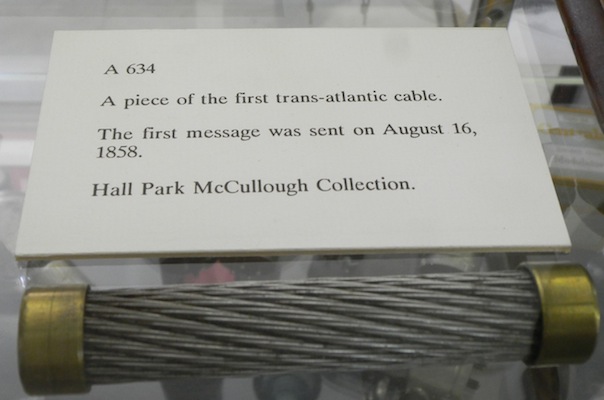
My musically-astute friend and I found ourselves in mid-October enjoying the environs of Bennington, Vermont. An artistically-astute friend had some time before emailed me, urging me to see the Milton Avery exhibit going on at the Bennington Museum, and the timing worked out. (There’s an image of a wonderful Milton Avery painting after the jump.)
In addition to the Milton Avery exhibit (which just closed), the Bennington Museum permanently houses the largest Grandma Moses collection this side of Proxima Centauri (those clever aliens bought in big, when the market was really cheap). I must confess that my reaction to Grandma Moses always was, “OK, yeah;” but, seeing the paintings live, there’s really a lot more going on than a person might have gleaned from LIFE magazine, back in the day.
There was a vitrine holding artifacts from Grandma Moses’ painting workbench. I at first was puzzled by the glass jar of silver glitter, but it then dawned on me that she must have used the glitter to make her snowscapes sparkle; and, sure enough, the proof was hanging on the walls. The Bennington Museum asks visitors to refrain from photographing the Moses pictures, in that the Museum sells books and postcards. I imagine those constitute major sources of revenue, and so of course I complied.
However, there was no ukase prohibiting (non-flash) photography elsewhere; and so, when I was brought up short by seeing, in a vitrine in the hall dedicated to material culture and technology, an item the claimed to be a piece of the first transatlantic telegraph cable, I snapped the photo you see above.
History of technology lesson and philosophical musings, after the jump.
NB, the first transatlantic messages were exchanged more than two years before Abraham Lincoln took office! Continue Reading →
L. Subramaniam: Electric Modes
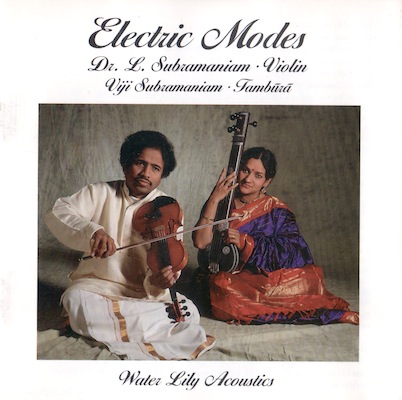
Lakshminarayana Subramaniam: Electric Modes
L. Subramaniam, electric violin; Viji Subramaniam, tambura; uncredited musicians, mridangam and ghatam.
2-CD set Water Lily Acoustics WLA-ES-5&6 (o.o.p.)
Recorded May 1987, Our Lady of Mount Carmel, Santa Barbara; November 1987, Unitarian Church, Santa Barbara; and September 1990, First Presbyterian Church, Santa Barbara. L. Subramaniam and Kavichandran Alexander, producers; Kavichandran Alexander, engineer. (Available via streaming from Tidal; via streaming and MP3 downloads from Amazon; from iTunes; used CDs and LPs are found on eBay and Amazon.)
California’s audiophile label Water Lily Acoustics achieved the dream of most independent music producers by winning the Grammy award in 1994 for Ry Cooder and V.M. Bhatt’s A Meeting By the River. No question, that is a very worthwhile recording.
However, that said, if I had to pick one recording from the Water Lily catalog that was even more musically substantial, it would be L. Subramaniam’s Muddy Waters-inspired Electric Modes. The sound samples over the jump are rather mind-boggling. The original LPs and the CD reissue are long out of print, but through the magic of streaming services, this magnificent music is readily available.
Some background, and the rather stunning sound samples, after the jump. Continue Reading →


